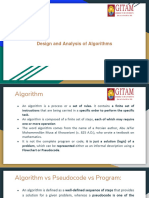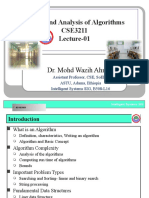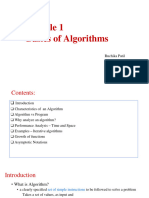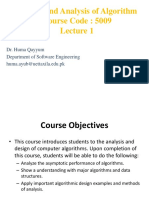0% found this document useful (0 votes)
25 views5 pagesDesign and Analysis of Algorithms
The document provides an introduction to algorithms, defining them as systematic sequences of instructions for problem-solving, and outlines their key characteristics such as input, output, definiteness, finiteness, and effectiveness. It discusses the importance of algorithms in simplifying complex problems, optimizing performance, and includes concepts like pseudocode, algorithm complexity, and trade-offs. Additionally, it highlights qualities of good algorithms and the significance of analyzing their efficiency through various notations and growth rates.
Uploaded by
mahinshanavas321Copyright
© © All Rights Reserved
We take content rights seriously. If you suspect this is your content, claim it here.
Available Formats
Download as PDF, TXT or read online on Scribd
0% found this document useful (0 votes)
25 views5 pagesDesign and Analysis of Algorithms
The document provides an introduction to algorithms, defining them as systematic sequences of instructions for problem-solving, and outlines their key characteristics such as input, output, definiteness, finiteness, and effectiveness. It discusses the importance of algorithms in simplifying complex problems, optimizing performance, and includes concepts like pseudocode, algorithm complexity, and trade-offs. Additionally, it highlights qualities of good algorithms and the significance of analyzing their efficiency through various notations and growth rates.
Uploaded by
mahinshanavas321Copyright
© © All Rights Reserved
We take content rights seriously. If you suspect this is your content, claim it here.
Available Formats
Download as PDF, TXT or read online on Scribd
/ 5























































































